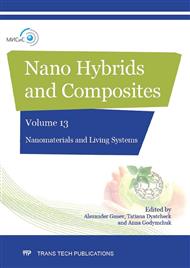p.75
p.82
p.91
p.96
p.102
p.108
p.115
p.123
p.130
Influence of Superfine Materials on the Vegetative Reproduction of Black Currant
Abstract:
We studied the influence of superfine materials on the rooting ability and development of softwood cuttings of Ribes nigrum. The inhibiting effect of the soil amended with ZnO and Pt nanoparticles at the concentration of 5 mg/kg of substrate on the rhizogenesis of black currant cuttings was stated. On adding the suspension of ZnO nanoparticles the rooting ability of cuttings decreased by 32.3 %, and under the influence of Pt nanoparticles – by 41.4 %. The decrease in the morphometric parameters of development of the cuttings’ above-ground part and roots (growth amount, number of cratches and leaves, number of roots and their length) was observed. The change in the biochemical composition of leaves in the cuttings was stated. In the replication with zinc oxide the concentration of chlorophyll in leaves significantly decreased by 21.8 %. Under the influence of Pt the concentration of flavonoids in leaves increased by 48.8 %.
Info:
Periodical:
Pages:
102-107
Citation:
Online since:
January 2017
Price:
Сopyright:
© 2017 Trans Tech Publications Ltd. All Rights Reserved
Share:
Citation:


